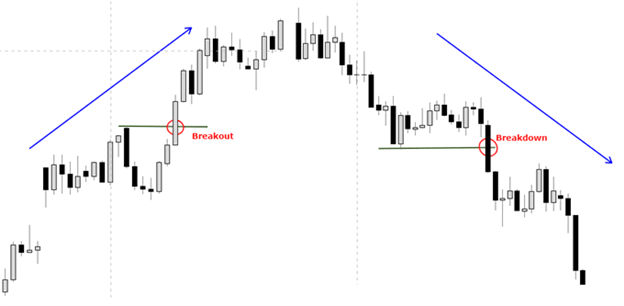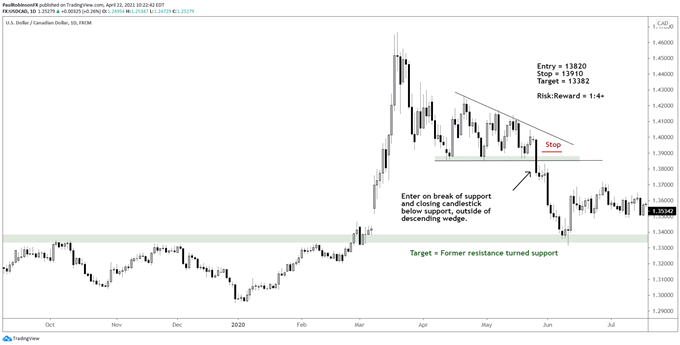In this piece I will discuss two core strategies; one entails entering on a retracement in price, or a pullback, and upon a breakout above or below an important technical level. These strategies each have their advantages and disadvantages, often as a function of the current type of market/volatility environment.
THE PULLBACK TRADE
The pullback trade is predicated on the idea that the short-term countertrend price action (correction) will be short-lived and that the broader trend will resume once the correction is over.
The post-breakout pullback is what it sounds like – the first pullback following a breakout. This can be one of the highest quality pullbacks you will get for establishing a position, as it appears early in what may become the beginning of an extended trend. Thus, these pullbacks can be some of the most rewarding.
When to enter
Entries on pullback trades can be taken based on a number of factors, but there are two which I deem to be the most important. The first factor is the availability of support or resistance. By having support or resistance available, you provide yourself with a point at which the market is showing demand (support) and supply (resistance).
If the market is in an uptrend, it is ideal that support is tested during the retracement before resuming higher. In a downtrend, resistance becomes the level you want to see price pull back to before seeing the trend resume lower.
It is ideal to have confluence of support and resistance. Confluence is key to finding the strongest forms of support and resistance. These could be intersections of various types of levels; horizontal levels, trend-lines, slopes, Fibonacci, moving averages are a few to mention.
The second part of entry equation entails the price action. Once either support or resistance is met it is ideal to see a strong reaction. That is, confirming price action that demonstrates market participants are in demand for prices to go higher or in supply that will help drive prices lower. Candlesticks are a great way of seeing this demand/supply dynamic at work.
For example, reversal candles that have small bodies with long tails (i.e. bullish hammers, bearish shooting stars) can be excellent markers that a retracement has runs its course. To see these occur at a key chart level strengthens the case. There are of course other candle types, such as a bullish or bearish engulfing candles, but the point is that you use some form of price action analysis in conjunction with the important support and resistance thresholds you’ve identified on the charts.
Risk management
Placing stops should make sense within the context of your analysis. Stops should be set out of harm’s way, beyond the support or resistance levels in question. For longs, stops should be placed beneath support, and for shorts the stop should be placed above resistance.
Targets should be set using your analysis the same way you set your stops. For longs, you are looking to resistance levels that may prevent the market from continuing higher. And for shorts you are looking to support levels that may potentially stop the market from continuing to decline.
The distances from your entry to your stop and entry to the target levels are what determines the initial set of risk parameters. You want to strive for a robust risk/reward ratio, preferably 1:2 or better. For example, a long trade that has an entry of 100, stop at 99, and target at 102 gives you a robust risk/reward ratio of 1 to 2.
Example of Pullback Trade

Created with Tradingview
THE BREAKOUT TRADE
This type of trade emerges after a period when the market is retracing or from rangebound type price action. These can form within the context of an established trend or during a trendless period when the breakout itself may be the beginning of an extended trending period.
The trend breakout entails a trending market with a pullback followed by a breakout above the most recent swing high (for longs) or swing low (for shorts). The range breakout is simply identifying a period where the market has undergone an extended process of horizontal trading, and price either moves above resistance (for longs) or below support (for shorts). Horizontal price action can also form chart patterns that result in breakouts; most popular are wedges/triangles, rectangles, flags/pennants, and head-and-shoulders.
PRICE BREAKOUTS (BULLISH & BEARISH)

When to enter
There are multiple approaches that can be taken. One can enter the market as soon as the price level in question is crossed, wait until there is a closing candlestick or bar beyond support or resistance, or some combination of the two. The closing candle method offers the most confirmation, but it can also mean missing out on some or all of the move in the event the breakout is extremely powerful. One of the benefits, however, is that by waiting for a closing print above or below support you will sidestep a lot of false breakouts.
This is why combining the two execution strategies can be a nice down-the-middle approach that brings the best of both techniques. For example, you could enter 50% of your max position size as soon as the breakout level is crossed and the other 50% once there is a closing print beyond the breakout level.
If you enter and the market doesn’t confirm, then you will lose on a position that is half the normal size. And if there is a confirmed breakout, you will enter the full position, allowing you to take advantage of the breakout with a full-sized position while increasing the odds that it won’t fail.
Risk management
The distance from your entry to stop (entry +/- stop) and distance from entry to the target(s) should have an asymmetrical risk profile providing somewhere around a 1:2 risk/reward ratio or better. For longs, stops should be placed sufficiently below the breakout level (resistance) and for shorts below the breakout level (support).
For pattern breakouts, given they are a little trickier due to the subjective nature of price patterns, waiting for a closing candle outside of the pattern before entering is a prudent approach.
Targets should be determined using your analysis, as is the case with any trade.
Example of a Breakout Trade

For the full conversation and all examples, please see the video above…
—Written by Paul Robinson, Market Analyst
You can follow Paul on Twitter at @PaulRobinsonFX

 Signal2forex.com - Best Forex robots and signals
Signal2forex.com - Best Forex robots and signals




